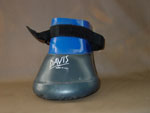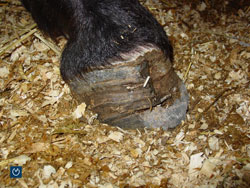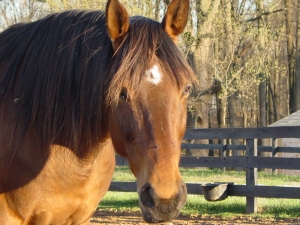|
Hoof Abscesses are Painful!Hoof abscesses are one of the most alarming hoof problems because the horse is so miserable.
Once it drains, the horse usually feels immediate relief. Signs of an Active Infection
What to do if you suspect a Hoof Abscess
Here is my story to make you feel better if you can't stand to see your horse in pain. 
Soaking boots are helpful. Warm water with your favorite additive will soften the hoof and facilitate draining.
Make sure to get the water over the coronary band. This seems to give the most relief. Hoof Solutions If you choose to bandage or poultice the foot, Hoof Solutions has some great products to make the process much easier.
To Use the Knife or Not?Sometimes the abscess can be opened up and drained. This will give the horse immediate relief. It is the build up of pressure that causes so much pain. But, finding the specific infected region is not always easy. Small holes in the sole heal quickly and present no problems. If the exact area is not found with pinpoint accuracy, then too much of the sole is removed or thinned. In this case, the hoof will need to be protected for an extended period of time so that the sole can re-grow. I prefer soaking and letting them burst on their own, but sometimes the affected area is obvious and I will use the tip of my hoof knife to open it. I have the benefit of seeing how lots of owners deal. Abscesses are a little like the common cold, take care of them and the horse gets better. Ignore them and the horse gets better. Soaking
There isn't an exact recipe for using either of these products. I usually throw in a large handful of salts. If you add too much it will just settle on the bottom and not go into solution. No harm done. With Apple Cider Vinegar, I have seen dilutions using one part vinegar to nine parts warm water up to equal parts of water and vinegar. That is a huge variation. Obviously, the specific formula isn't important. Too much vinegar can be irritating though. How long before My Horse Will Heal?
There is one other scenario. I had a horse remind me of it recently.
Sometimes the abscess is so large that it actually has a hard time being expelled. There is such a large affected area that the pressure cannot build enough to push the exudate out. The horse is really miserable for a while, just like with the smaller abscesses. The way you know the difference between a really large, slow to expel abscess and a small one what it looks like when it drains. This particular horse had the misfortune of bad timing. All of his people were out of town at the same time. I knew he was working on an abscess. I even talked to his vet and we both agreed to let it run its course. So, I left town, his vet left town, his owners went on vacation and his usual caretaker was gone. We received word that he was terribly sore despite frequent soaks. When I finally got back to him, he had blown the abscess out the coronary band and throughout the heel bulbs. He felt a million times better. It was obvious he had what is referred to as a sub-solar abscess. In the months to come, he will shed the frog, sole and probably the bars on his foot. It will look really alarming when this happens, but it is only evidence of a long ago problem. If he is going to be worked or has to deal with rocky areas, he will need a little extra protection, but otherwise it will be fine. Think of abscesses like splinters. Size and placement matters. At times I will look down and see a splinter in the callous of my hand and didn’t even feel it. Other times, they hurt like crazy, get infected and fester. That serumy material serves a purpose, it floats the foreign body out of my hand. Once it is gone, everything heals up nicely. When the horse has an irritant in the hoof. The horse's body has to make a decision how to heal this area. If it is big or particularly foreign, the body goes into high gear, sends all kinds of signals to expel this tissue. These are the hoof abscesses that come on strong and hurt the most. This is like a big, invasive splinter that festers up and gets really irritated. The body works hard to kick it out. Then there is the slow festering type of abscess. It is like the little splinter you get in your finger. The body isn't particularly anxious about getting rid of it, so it is annoyingly persistent. With this type of abscess in the hoof, I think the body is trying to decide whether to kick this tissue out or to reabsorb it. Then there are the tiny little pockets you see. Most often these are in the heel buttresses or the lamina, or on the bars. They are black and look bad, but the horse is oblivious to them. The body is reabsorbing or walling off the infection so that it can harmlessly grow out. So, the answer to the question is.....depends. After the Hoof Abscess has BurstA poultice pad may help drain the infection completely. I usually keep applying these as long as the wound is draining. After that, I leave the hoof un-wrapped. This is a personal call. |


